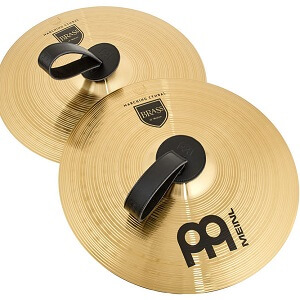Cymbal
 The name cymbal (also cimbel or cymbel) comes from the Latin cymbalum (plural cymbala for a pair of cymbals) which in turn derives from the Greek kumbalon (cup).
The name cymbal (also cimbel or cymbel) comes from the Latin cymbalum (plural cymbala for a pair of cymbals) which in turn derives from the Greek kumbalon (cup).
Cymbals originated in Asia and are among the oldest percussion instruments. They have always been closely associated with religious worship and rituals (e.g. funeral rites), although they were also used to accompany dances; dancers hung cymbals around their necks on a piece of twine and beat them in time to the music. Cymbals were only ever used in pairs and the playing techniques included single strokes, strisciatti (rotating both plates against each other) and rolls.
Cymbals were first introduced into Europe in the Middle Ages by the Saracens, who brought them to Spain and southern Italy. However, at the beginning of the last millennium they disappeared again, probably because the art of hammering had been lost. Despite this, portrayals of cymbals can be found in medieval miniatures up to about the 15th century.
It was in the last thirty years of the 19th century that the cymbals finally established themselves as a permanent part of the percussion section. They were used very effectively by Ludwig van Beethoven (in his 9th Symphony), Georges Bizet (in Carmen), Franz Liszt and Richard Wagner among others.